| Article ID | Journal | Published Year | Pages | File Type |
|---|---|---|---|---|
| 74003 | Microporous and Mesoporous Materials | 2012 | 9 Pages |
Anionic surfactant-templated mesoporous silicas (AMS) are synthesized with a co-structure directing agent (CSDA) that interacts with both the organic and inorganic components of the system. The AMS materials structure is controlled by pH. We investigated the formation of AMS cubic and hexagonal phases, prepared under the same conditions, except pH, by EPR spectroscopic measurements. We used silica-like and surfactant-like spin probes added to the reaction mixtures in minute amounts. Through the spin probes we resolved the specific interactions of the CSDA (N-trimethoxylsilylpropyl-N,N,N-trimethyl ammonium chloride (TMAPS)) with the surfactant (sodium myristate (C14AS)) and the polymerizing silica. We observed for both phases a fast formation of a mesophase upon addition of the silica precursor (TEOS, tetraethoxysilane) and the CSDA into the surfactant solution, attributed to the strong attraction between the CSDA and the anionic surfactant. This is then followed by a slow condensation of the silica. Electron spin echo envelope modulation (ESEEM) spectra of both spin probes in the as-synthesized materials indicated the presence of two types of CSDA molecules; one interacting with the surfactant and the other with the silica wall. Continuous wave EPR spectra showed different spin probe motilities in the two as-synthesized materials that indicated that the relative populations of the two CSDA types are different in the two phases. We attribute this difference to the pH differences in the reaction mixtures. A soft extraction of the surfactant from the pores did not alter the structure of the final materials, but it abolished the observed molecular level differences between them. The extraction allowed the pending ammonium groups to acquire a high degree of freedom and accessibility to water molecules.
Graphical abstractFigure optionsDownload full-size imageDownload as PowerPoint slideHighlights► Surfactant-co-structure directing agent (CSDA) interactions were observed experimentally. ► Cubic and hexagonal phases show fast assembly followed by slow precipitation. ► Two populations of CSDA were detected. ► The ratio between the two populations is different in hexagonal and cubic phase. ► Surfactant extraction removes molecular differences between different phases.
